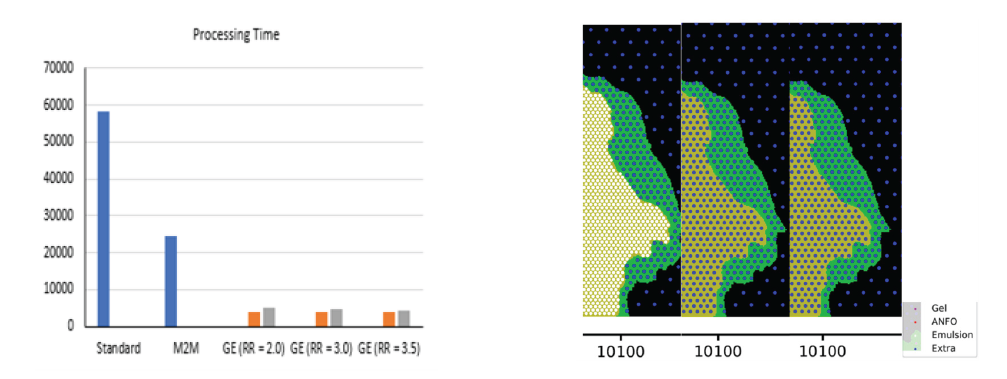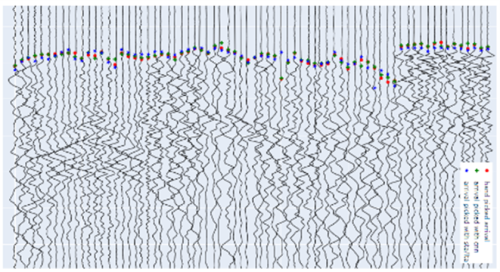The following is an article from CSIRO which appeared in the SSIM 2023 Supplement
Integrated and intelligent geoscience
by Dr Ewan J Sellers, Dr Ebrahim F Salmi, Dr Yi (Joey) Duan, Dr Pengyu Huang, CSIRO Mineral Resources
Introduction
Many of the readily accessible high-grade and homogenous ore deposits suitable for surface mining have already been mined or are currently in the extraction process. Research is therefore required to consider new ways to mine the future heterogeneous, and lower grade, ore safely and effectively. Mines will preferably use systems engineering approaches with selective, optimised extraction methods, considering the constraints created by geological, social and environmental requirements. An integrated approach to geoscience coupled with large-scale automated sensing, linked to modern numerical analysis, provides the geotechnical understanding to enable large-scale extraction of complex orebodies. This article presents three examples illustrating how existing, well-tested technologies are being upscaled to explore pathways towards an intelligent, automated and efficient mine of the future.
Smart design by selective blasting for environmental, social and governance
CSIRO has undertaken extensive exploration of the application of selective blasting techniques within the mining industry, with a primary focus on their integration to assist in meeting their environmental, social and governance (ESG) objectives. Preferential grade by size (PGS) (Carrasco et al. 2016) plays a critical role in optimising mineral recovery by applying sorting and sieving to remove the waste from ore at the very early stages of mining (Salmi et al. 2022; Sellers et al. 2023), exclusive conveyance of upgraded ore to the processing plant and ensuring the separation and disposal of waste materials into dry, coarse fractions. The CSIRO studies provide an integrated approach to create a superior approach to blast design, specifically tailored for the complex nature of heterogeneous and low-grade critical minerals deposits such as copper, lead and zinc.
Prototype software has been designed to ingest high-resolution data pertaining to rock mass mechanical characteristics (e.g. density, rock strength and fracture frequency), geological attributes (e.g. grade) and geo-metallurgical properties (e.g. rock hardness and ranking response). When tested on monometallic copper and polymetallic lead and zinc ores, case study analyses underscore that, when orebodies exhibit a high-ranking response, the integrated approach of grade engineering has the potential to significantly reduce processing times (see Figure 1a) which curtails comminution costs and the energy associated with the grinding of rock materials, enhances plant throughput, and augments the profitability derived from ore-processing operations. Figure 1b depicts how simulations adjust the blast patterns to the heterogeneous ore distribution.

Automation of microseismic monitoring using convolutional neural networks
Understanding the heterogeneity of the rock mass becomes key to improved productivity and energy efficiency. Large-scale microseismic analysis enables visualisation of the rock mass and is facilitated by distributed acoustic sensing (DAS) using fibre optics. DAS produces vast quantities of data, and the key to rapid and widespread application is accurate picking of the first seismic arrivals. This is essential for obtaining the correct source location in microseismic monitoring. The short-term-average over long-term-average (STA/LTA) method has been widely used for arrival time picking. However, the reliability of this method is sensitive to noise and requires careful selection of parameters and characteristic functions (CF). It is crucial to develop more robust arrival-time picking methods for microseismic monitoring in mines.
In this research, CSIRO investigated the convolutional neural network (CNN) method for picking the first arrivals in seismic data. We developed and tested a 1D CNN model using synthetic seismic data as well as seismic data recorded from our field projects. The results have shown that the proposed CNN method is more robust for accurately picking seismic event arrival times. We tested this method on DAS data and obtained excellent results. The parameters and CFs of traditional STA/LTA are optimised for arrival-time picking as a benchmark for arrival-time accuracy comparison with the CNN model. Both synthetic seismic data and DAS data collected from a mine site are used for the arrival-time picking test. The results demonstrate that the accuracy of arrivals obtained by CNN is ~2–3 times greater than that obtained by STA/LTA on synthetic and field data.

Novel numerical analysis using the material point method
Harvesting the orebodies in deep and complex geological and geotechnical settings can be a challenging task. Numerical modelling of the mining activities can help us better understand and predict the rock mass behaviours in various environmental and loading conditions. As an alternative to conventional methods, CSIRO is applying the material point method (MPM) with strain softening Mohr–Coulomb model and a tension cutoff criterion to model the movement of the yield rock masses as it can simulate the large deformation of the rock mass by combining the advantages of Lagrange (material points) and Euler descriptions (background mesh) (Fern et al. 2019). In the MPM formulation, the continuum body is represented by a set of Lagrangian material points. These store all the physical information of the body. The momentum equations are then solved in the background mesh, and the physical information of the material points is updated accordingly, which can avoid the mesh-distortion issues of the finite element method due to large deformation.
An example of modelling in 2D of cave propagation to an undercut area 600 m below the surface is shown in Figure 3. The large deformation of the rock mass can also be observed as the damaged rock mass fell into the undercut area. With further development, the MPM can be a promising tool to help us better understand the geotechnical mechanisms in mining and how caving affects the subsidence in open pit-to-cave transition.

Conclusion
Geotechnical engineering has been at the forefront of mining innovation for many years. Currently, the widespread increase in the amount, availability and coverage of sensing systems enables an integration of mine design with large-scale, real-time geoscience information. Firstly, we can now bring energy efficiency and ESG considerations into optimal value chain solutions. Secondly, microseismics with fibre optic DAS provides practitioners with the opportunity for large-scale understanding of the rock strength and structure heterogeneity. Thirdly, new, efficient modelling techniques enable real-time connections between the rock mass and operating practices. The aim of these examples is to inspire others to connect and further develop the integrated and intelligent geoscience system enabling future mining operations.
References
Carrasco, C, Keeney, L & Walters, SG 2016, ‘Development of a novel methodology to characterise preferential grade by size deportment and its operational significance’. Minerals Engineering, vol. 91, pp. 100–107, https://doi.org/10.1016/j.mineng.2015.08.013
Salmi, EF, Mousavi, A, Usami, K & Sellers, EJ 2022, ‘Value chain optimization for grade engineering by mine-wide fragmentation optimisation’, Proceedings of The 13th International Symposium on Rock Fragmentation by Blasting,
pp. 733–744.
Sellers, E, Usami, K, Mousavi, A, Kettle, A & Salmi, EF 2023, ‘Blasting for net zero emissions’, Proceedings of The 26th World Mining Congress, pp. 2302–2315.
Fern, J, Rohe, A, Soga, K & Alonso, E (eds) 2019, The Material Point Method for Geotechnical Engineering:
A Practical Guide, CRC Press, Boca Raton.

EJ Sellers, CSIRO

EF Salmi, CSIRO

Y Duan, CSIRO

P Huang, CSIRO

